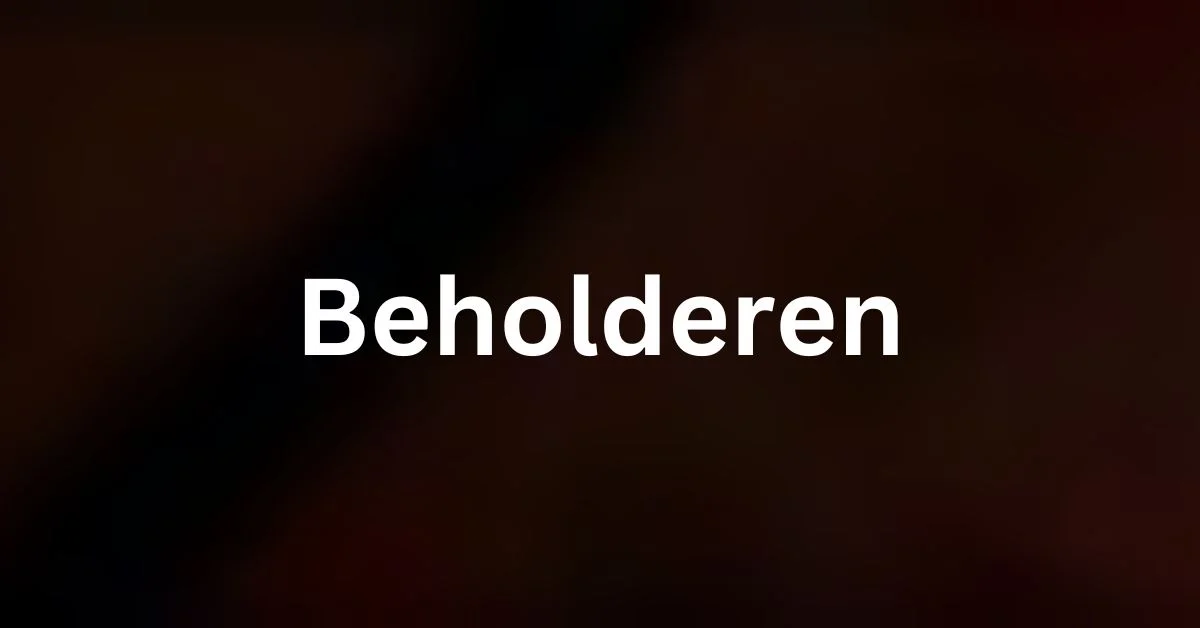In the expansive realms of fantasy literature and games, few creatures are as iconic or terrifying as the Beholderen. Known for their vast powers, strange anatomy, and eerie intellect, Beholders are often depicted as beings of malevolent intelligence, paranoia, and unmatched magical prowess. Their presence in a world can signify the tipping point of balance, marking the rise of a power too great for mere mortals to challenge.
This article aims to delve deep into the lore, characteristics, and significance of Beholders, exploring their origins, abilities, and roles in various fictional universes, with a particular focus on their appearances in Dungeons & Dragons (D&D), the most prominent fantasy tabletop role-playing game where they gained fame.
Origins and Creation of the Beholder
The Beholder’s origins are most commonly associated with Dungeons & Dragons, where they were first introduced in the original 1975 “Greyhawk” supplement. Conceived by Gary Gygax and Terry Kuntz, these creatures have since become one of the most well-known monsters in fantasy gaming history. However, their influence has spread far beyond the confines of D&D, inspiring similar beings in books, movies, and video games.
While their real-world creation stems from the imagination of D&D’s creators, within the lore of D&D itself, Beholders are said to originate from an alien plane of existence. These otherworldly beings defy typical notions of biology, resembling nothing from the natural world. Their unique biology and powerful abilities suggest they might be creatures from a realm far removed from the material world, possibly even predating the known universe.
In some D&D campaigns, Beholders are said to have been born from dreams—nightmares, specifically. It is believed that a Beholder dreaming of another Beholder may actually spawn a new one into existence, emphasizing their deeply alien and surreal nature. This phenomenon gives the Beholders a near-godlike status in some interpretations, where they act as creators of their own kind, shaping reality itself through mere thought.
Anatomy of a Beholder
The Beholder’s physical appearance is one of the most bizarre in fantasy literature. A typical Beholder is a large, spherical creature, often described as being around six to eight feet in diameter. Its most defining feature is its massive central eye, which dominates the front of its body, flanked by a gaping maw filled with sharp teeth. Floating above its body are ten eye stalks, each equipped with a smaller but no less dangerous eye. These stalks can rotate and move independently, giving the Beholder a complete 360-degree field of vision, making it virtually impossible to sneak up on.
Each of the Beholder’s eyes possesses a different magical ability, making it one of the most dangerous creatures to confront in combat. These abilities can range from paralyzing rays to disintegration beams, and in some cases, even the power to turn enemies to stone. The central eye of the Beholder has its own unique power: it generates an anti-magic field, capable of nullifying any magical effects within its sight. This makes the Beholder especially deadly to spellcasters, as it can neutralize their spells with ease, leaving them vulnerable to its deadly eye beams.
The Beholder’s ability to fly is not due to wings or any visible propulsion but is instead a product of its innate magical nature. This levitation allows it to move effortlessly through the air, often in dark, labyrinthine lairs filled with traps, where its various powers can be used to maximum advantage.
Beholder Psychology and Society
Beholders are known not only for their physical power but also for their unmatched intellect and paranoia. Each Beholder believes itself to be the pinnacle of evolution, the most perfect being in existence. This extreme narcissism leads Beholders to distrust and despise all other beings, especially other Beholders. A Beholder will see others of its kind as abominations or inferior versions of itself, often leading to violent conflicts between them. In fact, many Beholders live in complete isolation, choosing to trust no one and relying on their own power and intelligence to control their domains.
Their paranoia is so deep-rooted that Beholders will often construct elaborate lairs filled with traps, secret doors, and magical protections to prevent any being from approaching them unnoticed. These lairs, often located deep underground or in remote locations, become fortresses of solitude where a Beholder can plot and scheme without fear of intrusion.
Despite their isolationist tendencies, Beholders are not without influence in the broader world. Some Beholders enslave other creatures, using their vast magical powers to bend lesser beings to their will. These minions serve the Beholder in various capacities, often acting as eyes and ears in the outside world, gathering information and bringing back resources to their master.
Beholders are also known to be avid collectors of magical artifacts and ancient knowledge. They are deeply fascinated by the arcane and will go to great lengths to acquire powerful relics that can augment their already fearsome abilities. A Beholder’s lair may be filled with centuries’ worth of treasures and knowledge, making them tempting targets for adventurers—though the danger of confronting such a creature often outweighs the potential rewards.
Variations of Beholders
Though the Beholder is often depicted as a solitary creature, variations of this iconic monster exist throughout different fantasy settings, particularly within Dungeons & Dragons itself. These variations add to the depth and complexity of the Beholder as a species, showcasing how diverse and adaptable these creatures can be.
Beholderkin
Not all Beholders are created equal. Beholderkin is a term used to describe the various offshoots of the primary Beholder species, typically smaller or less powerful than a true Beholder. These creatures may possess some of the same eye-based abilities but lack the raw power and intellect of a full-fledged Beholder. Some examples of Beholderkin include.
Spectators
These are smaller, more benign versions of Beholders that are often summoned to guard specific locations or objects. While they possess fewer eye stalks and weaker abilities, they are still formidable opponents in their own right.
Gauths
These Beholderkin are distinguished by their fewer eyes and more vampiric tendencies, often draining magical energy from their victims to sustain themselves.
Death Tyrants
Death Tyrants are undead versions of Beholders, often created when a Beholder’s natural paranoia drives it to experiment with necromancy in an attempt to achieve immortality. The result is a floating skull, still equipped with its deadly eye rays, but imbued with the powers of undeath. A Death Tyrant is even more dangerous than a regular Beholder, as it combines the power of a Beholder with the relentless endurance of an undead being.
Death Tyrants are often surrounded by legions of undead minions, as their mere presence can raise the dead to serve them. This makes them powerful rulers of vast, undead armies, capable of laying waste to entire civilizations.
Hive Mothers and Elder Orbs
While most Beholders live in isolation, some rare Beholders are capable of leading others of their kind. Hive Mothers, also known as Ultimate Tyrants, are Beholders that possess the ability to dominate and control other Beholders. These powerful beings act as leaders of Beholder communities, enforcing their will upon lesser Beholders and expanding their influence across the planes.
Elder Orbs are ancient Beholders that have lived for centuries, often acquiring vast amounts of knowledge and power in the process. These beings are considered some of the most dangerous creatures in existence, as they combine the intelligence and magical prowess of a Beholder with centuries of experience and cunning.
Beholders in Popular Culture
The Beholder has become a symbol of fear and power in fantasy literature, movies, and video games, thanks in large part to its iconic status in Dungeons & Dragons. Over the years, Beholders have appeared in a wide variety of media, solidifying their place as one of the most recognizable monsters in popular culture.
Dungeons & Dragons
In Dungeons & Dragons, the Beholder is often used as a high-level encounter, reserved for the most experienced adventurers. Their combination of magical abilities, paranoia, and intelligence makes them a formidable opponent that requires careful planning and strategy to defeat. Many famous D&D campaigns and settings feature Beholders as major antagonists, including the Forgotten Realms and Greyhawk settings.
One of the most famous Beholders in D&D lore is Xanathar, a crime lord who operates in the city of Waterdeep. Xanathar is not only a powerful Beholder but also a mastermind of a vast criminal organization, showcasing the Beholder’s ability to exert influence far beyond its immediate surroundings.
Video Games and Other Media
Beholders have also made appearances in video games, particularly those based on or inspired by Dungeons & Dragons. Titles such as the Baldur’s Gate series, Neverwinter Nights, and Icewind Dale all feature Beholders as enemies that players must face. These games often portray Beholders as powerful, end-game bosses that require teamwork and tactical thinking to overcome.
Outside of D&D, Beholders have inspired similar creatures in other forms of media. In World of Warcraft, for example, there are creatures known as “Observer Demons” that bear a striking resemblance to Beholders, complete with floating eyeballs and magical attacks.
Conclusion
The Beholder stands as one of the most iconic monsters in fantasy, a creature whose appearance alone can strike fear into the hearts of even the bravest adventurers. With its strange biology, unmatched magical abilities, and deeply paranoid intellect, the Beholder represents the ultimate challenge for those who seek power and glory.
Its influence on popular culture, particularly through Dungeons & Dragons, has cemented its status as a symbol of malevolent power. Whether encountered as a lone tyrant in a dark dungeon or as the leader of a vast criminal empire, the Beholder remains a testament to the creativity and enduring legacy of fantasy storytelling.













+ There are no comments
Add yours